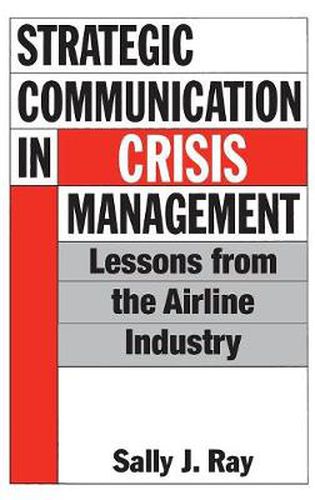Readings Newsletter
Become a Readings Member to make your shopping experience even easier.
Sign in or sign up for free!
You’re not far away from qualifying for FREE standard shipping within Australia
You’ve qualified for FREE standard shipping within Australia
The cart is loading…






Communicating successfully is crucial if an organization is to survive and recover from a crisis. Focusing on the airline industry and some of the most recent headline-making disasters, Dr. Ray looks at organizational crises, the communications strategies employed by organizations when responding to crises, and the factors that influence the effectiveness of this strategic communication. She maintains that our understanding of crisis and the implications for strategic crisis communications in all industries can be based on two valid assumptions. First, crises may be viewed in terms of phases. Second, they are best understood from a system perspective. This is particularly important when we realize that how stakeholders see crises and how professional communicators see them may be entirely different, and that their viewpoints will vary at various crisis stages.
Dr. Ray begins with an introduction that reviews the U.S. airline industry’s safety system, followed by a chapter on organizational crises and crisis communications. The remaining chapters are divided into sections reflecting Dr. Ray’s simplified model of crisis stages: pre-crisis, crisis, and post-crisis. Here she explores conditions which lead to major aviation disasters and other crises, contingency planning, crisis management, crisis communication, and post-crisis investigation by the National Transportation Safety Board. Seven chapters provide case studies of major airline disasters, analyzed according to her three-stage model, and an illuminating of the major issues associated with airline disasters. The cases also examine, analyze, and evaluate communication strategies used by airlines when responding to these issues and give readers important lessons to ponder, which she synthesizes in a conclusion. Corporate communications specialists at all levels, in the public and private sectors both, as well as executives with other management responsibilities will find Dr. Ray’s book informative, useful, and fascinating reading.
$9.00 standard shipping within Australia
FREE standard shipping within Australia for orders over $100.00
Express & International shipping calculated at checkout
Communicating successfully is crucial if an organization is to survive and recover from a crisis. Focusing on the airline industry and some of the most recent headline-making disasters, Dr. Ray looks at organizational crises, the communications strategies employed by organizations when responding to crises, and the factors that influence the effectiveness of this strategic communication. She maintains that our understanding of crisis and the implications for strategic crisis communications in all industries can be based on two valid assumptions. First, crises may be viewed in terms of phases. Second, they are best understood from a system perspective. This is particularly important when we realize that how stakeholders see crises and how professional communicators see them may be entirely different, and that their viewpoints will vary at various crisis stages.
Dr. Ray begins with an introduction that reviews the U.S. airline industry’s safety system, followed by a chapter on organizational crises and crisis communications. The remaining chapters are divided into sections reflecting Dr. Ray’s simplified model of crisis stages: pre-crisis, crisis, and post-crisis. Here she explores conditions which lead to major aviation disasters and other crises, contingency planning, crisis management, crisis communication, and post-crisis investigation by the National Transportation Safety Board. Seven chapters provide case studies of major airline disasters, analyzed according to her three-stage model, and an illuminating of the major issues associated with airline disasters. The cases also examine, analyze, and evaluate communication strategies used by airlines when responding to these issues and give readers important lessons to ponder, which she synthesizes in a conclusion. Corporate communications specialists at all levels, in the public and private sectors both, as well as executives with other management responsibilities will find Dr. Ray’s book informative, useful, and fascinating reading.